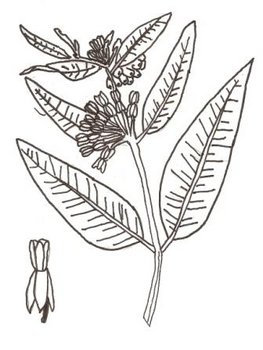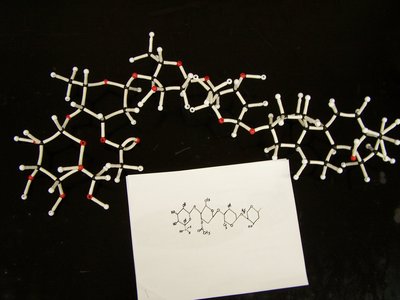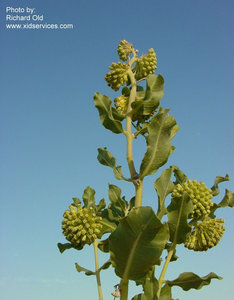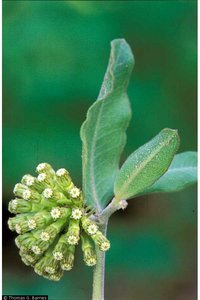 Portfolio: Medicinal Plants of the Sicangu Lakota
Portfolio: Medicinal Plants of the Sicangu Lakota
Investigation
Asclepias viridiflora by Hayden
1sagebrush9

Asclepias viridiflora. © 1sagebrush9
Lakota name: hu ciήśќá
 Listen to Lakota Plant Name: hu ciήśќá
Listen to Lakota Plant Name: hu ciήśќá
Scientific name: Asclepias viridiflora
Common name: Green comet milkweed
Historical use as a medicinal plant by the Lakota or any other Culture: The Lakota tribe had many medicinal uses for the Green Comet Milkweed. The roots of this plant are applied to the gums of babies to alleviate pain. They are also chewed by people who are suffering from diarrhea. The plant was used the help women in lactating. It was given to them to increase milk production. It has no current medicinal uses. The roots were stored for winter, when they would be used in spice soups.
Federal Status: Currently the US government has not posted this species as endangered. However, Conneticut, Florida, and New York have marked it as being threatened or of special concern. Based off the population and growth of these states in recent years, I am led to believe that housing developments might be at least one reason for their plight.
Description: A. viridiflora range in height from 1 to 3 feet. The flowers are approximately 1/4 inch across. This plant is native to the United States. Its leaves typically have an acuminate1 shape with an acute2 tip. It has opposite3 leaves that have a simple4 structure. It was commonly used by the Lakota and was given the name "hu ciήśќá" which means "spoon shaped leaf".
- 1 A long slender leaf, tapering to a point
- 2 Angle of less than 90 degrees
- 3 Leaves attach to the stem in pairs
- 4 Leaves are one, unseperated blade
Similar Species: The green comet milkweed is part of the genus Asclepias, which has at least 140 species. All of these species are considered milkweeds. The reason why they are called milk weeds is because of their secondary compounds that have a milk and water mixture look.
Secondary Compound: Cardiac Glycosides. Cardiac Glycosides work by slowing the sodium-potassium pump in heart cells. This increases sodium ions in the cell which causes an increase in calcium ions. This increase in calcium increases the functionality of the cell.

Click on an image to view larger version & data in a new window

Molecular structure of a cardiac glycoside. © 1sagebrush9
Flowering Period: The flowering period of this plant is from June to September. The flowers of this plant are very distinct, making the plant easy to pick out during its flowering period; however, during the rest of the year it blends in with its surrounding plants.
Habitat:
- Dry Areas
- Prairies
- Woods
- Inland Sands
- Barren Areas
- Sandy Soil
Information on the Internet
Learning Information
- ToL Learner Level:
- Target Grade/Age Level:
- Language:
Education Standards
State Education Standards
- South Dakota Education Standards
- 9-12.L.1.1. Students are able to relate cellular functions and processes to specialized structures within cells.
- 9-12.L.1.2. Students are able to classify organisms using characteristics and evolutionary relationships of major taxa.
- 9-12.S.1.1. Students are able to explain ethical roles and responsibilities of scientists and scientific research.
- 9-12.S.1.2. Students are able to evaluate and describe the impact of scientific discoveries on historical events and social, economic, and ethical issues.
- 9-12.N.1.1. Students are able to evaluate a scientific discovery to determine and describe how societal, cultural, and personal beliefs influence scientific investigations and interpretations.
- 9-12.N.2.1. Students are able to apply science process skills to design and conduct student investigations. (Synthesis)
- 9-12.N.2.2. Students are able to practice safe and effective laboratory techniques.
National Education Standards
- National Education Standards
CONTENT STANDARD A: As a result of activities in grades 9-12, all students should develop
- Abilities necessary to do scientific inquiry
- Understandings about scientific inquiry
CONTENT STANDARD B: As a result of their activities in grades 9-12, all students should develop an understanding of
- Structure of atoms
- Structure and properties of matter
- Chemical reactions
- Motions and forces
- Conservation of energy and increase in disorder
- Interactions of energy and matter
CONTENT STANDARD C: As a result of their activities in grades 9-12, all students should develop understanding of
- The cell
- Molecular basis of heredity
- Biological evolution
- Interdependence of organisms
- Matter, energy, and organization in living systems
- Behavior of organisms
CONTENT STANDARD E: As a result of activities in grades 9-12, all students should develop
- Abilities of technological design
- Understandings about science and technology
CONTENT STANDARD F: As a result of activities in grades 9-12, all students should develop understanding of
- Personal and community health
- Population growth
- Natural resources
- Environmental quality
- Natural and human-induced hazards
- Science and technology in local, national, and global challenges
CONTENT STANDARD G: As a result of activities in grades 9-12, all students should develop understanding of
- Science as a human endeavor
- Nature of scientific knowledge
- Historical perspectives
About This Page
Author: 1sagebrush9
Classroom Project: Medicinal Plants of the Lakota Sioux
Lead-Deadwood High School
Lead, South Dakota United States
License: Creative Commons Attribution License - Version 3.0
Correspondence regarding this page should be directed to , Lead-Deadwood High School
Page copyright © 2008 1sagebrush9
 Treehouses are authored by students, teachers, science enthusiasts, or professional scientists. Anyone can sign up as a treehouse contributor and share their knowledge and enthusiasm about organisms. Treehouse contributions are checked for general accuracy and quality by teachers and ToL editors, but they are not usually reviewed by expert scientists. If you spot an error, please get in touch with the author or the teacher. For more information about quality control of Tree of Life content, see Status of Tree of Life Pages.
Treehouses are authored by students, teachers, science enthusiasts, or professional scientists. Anyone can sign up as a treehouse contributor and share their knowledge and enthusiasm about organisms. Treehouse contributions are checked for general accuracy and quality by teachers and ToL editors, but they are not usually reviewed by expert scientists. If you spot an error, please get in touch with the author or the teacher. For more information about quality control of Tree of Life content, see Status of Tree of Life Pages.
About This Portfolio
I would like to acknowledge the following individuals for their help with this project:
- Rev. Raymond Bucko S.J., Creighton University Department of Sociology and Anthropology
- My student mentor Devan, Kim Loeffen, Tony Beisiot, Wade Mackey, and Sharon Burns for their technical help.
- F.J. Doody, Buechel Memorial Museum, St. Francis, S.D.
- Ben Black Bear Jr. for his audio of Lakota names, St. Francis, S.D. (Author of the Introduction of Dilwyn Rogers' Book of Father Buechel's research.)
- Katja Schulz Managing Editor ToL
- And mostly, my students for their perserverence!
Robin Cochran-Dirksen

Lead-Deadwood High School
Correspondence regarding this page should be directed to Robin Cochran-Dirksen at
Page copyright © 2008 Robin Cochran-Dirksen
 Listen to Lakota Plant Name: hu ciήśќá
Listen to Lakota Plant Name: hu ciήśќá









 Go to quick links
Go to quick search
Go to navigation for this section of the ToL site
Go to detailed links for the ToL site
Go to quick links
Go to quick search
Go to navigation for this section of the ToL site
Go to detailed links for the ToL site